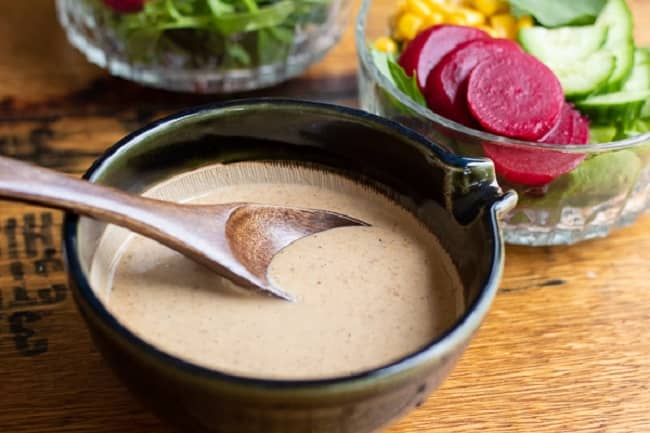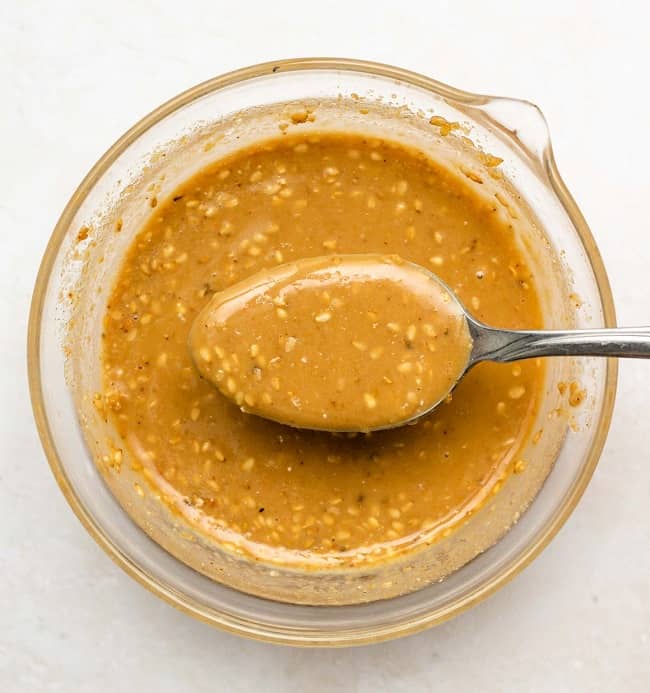This Japanese Salad Dressing tastes as if it came straight from a restaurant. This dressing is acidic, gingery, and sweet, with a hint of sweetness.
It’s also simple to make for a busy week or whenever you have a taste for Japanese salad dressing at home!
What Gives This Recipe Its Flavour?
- It tastes exactly like the dressing you’d get at your favorite Japanese eatery! The orange, ginger dressing that comes with your salad is one of my favorite aspects of coming to a hibachi restaurant. I would have made this
- Japanese salad dressing sooner if I had known how simple it was to make my own dressing at home! Seriously, this salad dressing is a carbon copy of the one served at hibachi restaurants.
- It only takes 5 minutes to prepare! Begin by cutting the veggies coarsely, then combining everything in a blender and pulsing for a few seconds. In no time, you’ll create the simplest and most delicious salad dressing.
- It’s packed with vegetables and surprisingly healthy. The healthful base of this Japanese salad dressing is made up of fresh carrots, ginger, and celery!
Important Ingredients

Soy sauce – This dressing’s characteristic savory flavor comes from soy sauce. If you choose, you can use gluten-free and/or low-sodium soy sauce.
Start with just two teaspoons of soy sauce and work your way up from there if you want to cut the sodium in this recipe.
Rice Vinegar – Most dressings contain vinegar or an acidic component of some sort. It is used to balance the tastes in this Japanese salad dressing.
Rice vinegar, which is primarily used in Asian cuisine, is slightly less acidic than most other vinegar, making it an ideal complement to this salad dressing.
You can substitute 2-3 tablespoons of white vinegar for rice vinegar if you don’t have any on hand.
Peanut Oil — You can replace the peanut oil in this recipe with any neutral-tasting oil of your choice. Peanut oil gives this dressing a subtle sweetness and nutty flavor.
Though you may use canola or vegetable oil in place of the peanut oil in this recipe!
Chef’s Advice
- Chill this Japanese salad dressing for at least 30 minutes before serving if you have the time. The flavors will develop over this period in the fridge, and there’s something about this dressing that tastes so much better when served cold.
- Refrigerate any leftover dressing in an airtight jar for up to 5 days. This Japanese salad dressing is a must-have for your weekly meal planning. Simply create this dressing at the beginning of the week and serve it over your salad throughout the week!
- Depending on your blender, you may have some difficulty pureeing this dressing to the desired consistency. If this happens to you, you can loosen things up by adding a tablespoon or two of water or additional oil. Begin with a little amount of liquid and progressively add more until you reach the desired pureed consistency!
Japanese Salad Dressing
| 5 minutes to prepare 5 minutes in total |
This easy-to-make Japanese salad dressing tastes as if it came straight from a restaurant. This dressing is acidic, gingery, and sweet, with a hint of sweetness.
It’s also simple to make for a busy week or whenever you have a taste for Japanese salad dressing at home!
Ingredients
- 1 cup carrots chopped
- ½ cup yellow onion chopped
- ¼ cup fresh ginger grated
- 2 tablespoons celery chopped
- ½ cup rice vinegar
- 1 tablespoon honey
- ¼ cup soy sauce
- ½ cup peanut oil
Equipment

- blender
Instructions For Japanese Salad Dressing
- In a blender, combine all of the ingredients and puree until smooth.
Notes
- Make it Paleo by substituting coconut aminos for soy sauce and avocado oil for peanut oil.
- Use maple syrup or white sugar instead of honey to make it vegan.
This recipe serves roughly 8 people. The nutritional data presented are for one serving out of eight, excluding salad. The macros may differ somewhat depending on the brand or type of ingredients used.
Prepare the recipe as directed, then weigh the completed product to calculate the size of one serving. Divide the total weight (excluding the weight of the food container) by eight. The weight of one serving will be the result.
Nutrition Information
Serving: 1serving, Calories: 148kcal, Carbohydrates: 6g, Protein: 1g, Fat: 14g, Saturated Fat: 2g, Sodium: 419mg, Potassium: 101mg, Fiber: 1g, Sugar: 4g, Vitamin A: 2682IU, Vitamin C: 2mg, Calcium: 11mg, Iron: 1mg, Net Carbs: 5g
